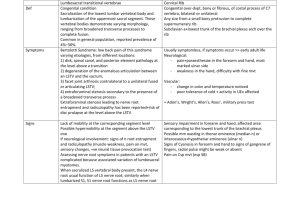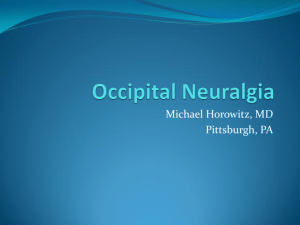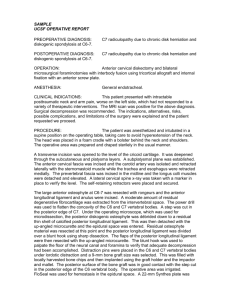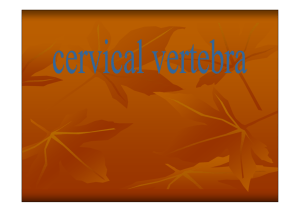Region 7 Superficial and Intermediate Extrinsic Back Cutaneous
advertisement
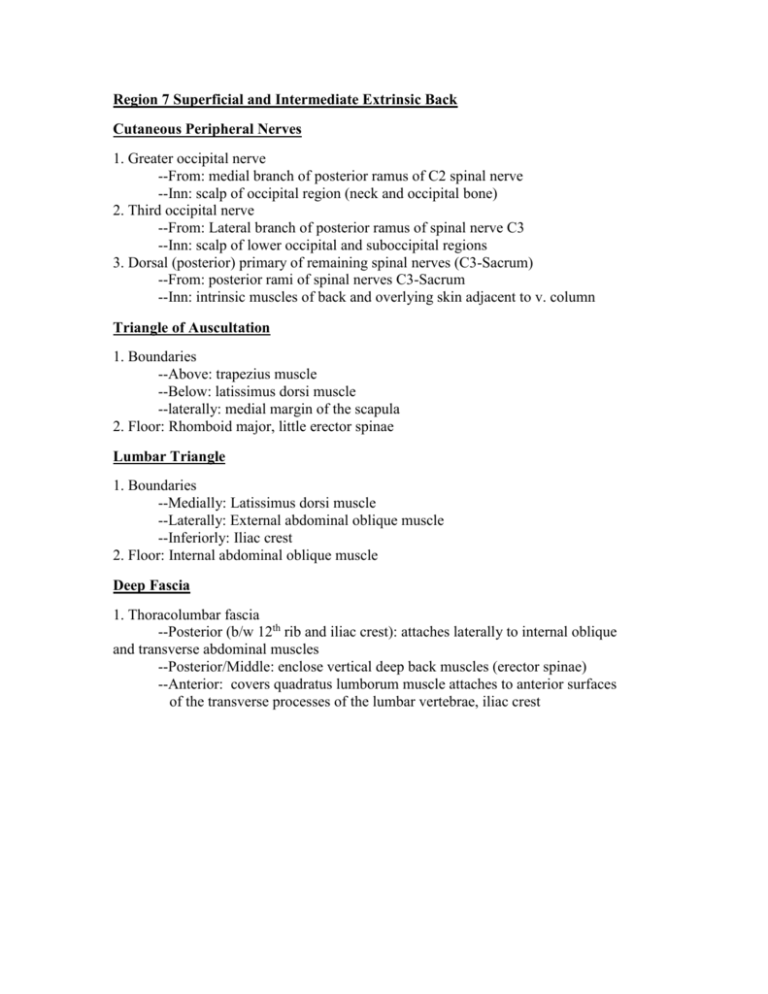
Region 7 Superficial and Intermediate Extrinsic Back Cutaneous Peripheral Nerves 1. Greater occipital nerve --From: medial branch of posterior ramus of C2 spinal nerve --Inn: scalp of occipital region (neck and occipital bone) 2. Third occipital nerve --From: Lateral branch of posterior ramus of spinal nerve C3 --Inn: scalp of lower occipital and suboccipital regions 3. Dorsal (posterior) primary of remaining spinal nerves (C3-Sacrum) --From: posterior rami of spinal nerves C3-Sacrum --Inn: intrinsic muscles of back and overlying skin adjacent to v. column Triangle of Auscultation 1. Boundaries --Above: trapezius muscle --Below: latissimus dorsi muscle --laterally: medial margin of the scapula 2. Floor: Rhomboid major, little erector spinae Lumbar Triangle 1. Boundaries --Medially: Latissimus dorsi muscle --Laterally: External abdominal oblique muscle --Inferiorly: Iliac crest 2. Floor: Internal abdominal oblique muscle Deep Fascia 1. Thoracolumbar fascia --Posterior (b/w 12th rib and iliac crest): attaches laterally to internal oblique and transverse abdominal muscles --Posterior/Middle: enclose vertical deep back muscles (erector spinae) --Anterior: covers quadratus lumborum muscle attaches to anterior surfaces of the transverse processes of the lumbar vertebrae, iliac crest Superficial Extrinsic Back Muscles Trapezius Medial third of superior nuchal line, EOP, nuchal ligament, spinous processes of C7-T12 I Lateral 1/3 of clavicle, acromion and spine of scapula Spinal accessory nerve (CN XI) MOTOR Inn. C3, C4 SENSORY (pain and proprioceptive fibers) Descending part: elevates, rotates glenoid cavity superiorly Act. Ascending part: depresses, rotates glenoid cavity superiorly Middle part/all parts: retracts scapula BS Superficial branch of transverse cervical a. O Latissimus dorsi Spinous processes of inferior 6 thoracic vertebrae, thoracolumbar fascia, iliac crest, inferior 3-4 ribs I Floor of intertubercular groove of humerus Inn. Thoracodorsal nerve (C6, C7, C8) Extends, adducts, medially rotates humerus; raises body toward arms during Act. climbing BS Thoracodorsal a. O Levator scapulae O I Inn. Act. Posterior tubercles of transverse process of C1-C4 Medial border of scapula superior to root of spine Dorsal scapular (C5) and cervical nerves (C3, C4) Elevates scapula, tilts glenoid caity inferiorly by rotating scapula BS Deep branch of transverse cervical a. OR dorsal scapular a. Rhomboid Minor O Nuchal ligament, spinous process of C7, T1 I Smooth triangular area at medial end of scapular spine Inn. Dorsal scapular nerve (C4, C5) Act. Retract scapula, rotate it to depress glenoid cavity, fix scapula to thoracic wall BS Deep branch of transverse cervical a. OR dorsal scapular a. Rhomboid Major O I Inn. Act. BS Spinous process of T2-T5 Medial border of scapula from level of spine to inferior angle, below root Dorsal scapular nerve Retract scapula, rotate it to depress glenoid cavity, fix scapula to thoracic wall Deep branch of transverse cervical a. OR dorsal scapular a. Blood Supplies to Superficial Extrinsic Back Muscles 1. Superficial branch of transverse cervical artery --From: thyrocervical trunk (a branch of the subclavian a.) --To: runs with CN XI 2. Deep branch of transverse cervical artery --From: thyrocervical trunk (a branch of the subclavian a.) --To: runs as the dorsal scapular a. with dorsal scapular n. 3. Thoracodorsal artery --From: subscapular artery 4. Dorsal scapular artery --From: deep branch of transverse cervical artery OR a branch from the 2nd or 3rd part of the subclavian Nerve Supplies to Superficial Extrinsic Back Muscles 1. Spinal accessory nerve (CN XI) --From: cranial nerve XI 2. Cervical nerves C3, C4 3. Thoracodorsal nerve --From: side branch of posterior cord fibers C6, C7, C8 4. Dorsal scapular nerve --From: posterior aspect of anterior ramus C5, frequent contribution from C4 ------------------------------------------------------------------------------------------------------------ Intermediate extrinsic back muscles Serratus Posterior Superior O I Inn. Act. BS Nuchal ligament, spinous processes of C7-T3 Superior borders of 2nd-4th ribs 2nd-5th intercostal nerves ELEVATES ribs Posterior intercostal aa, highest intercostal a. Serratus Posterior Inferior O I Inn. Act. BS Spinous processes of T11-L2 Inferior borders of 8th-12th ribs near their angles 9th-11th intercostal nerves, subcostal (T12) nerve DEPRESSES ribs Posterior intercostal aa. Blood Supply of Intermediate Extrinsic Back Muscles 1. Posterior intercostal arteries --From: thoracic aorta 2. Highest intercostal artery --From: supreme intercostal artery (from costocervical trunk on subclavian) Nerve Supply of Intermediate Extrinsic Back Muscles 1. 2nd-5th Intercostal nerves --From: Anterior rami of T1-T11 2. 9th-11th intercostal nerves --From: Anterior rami of T1-T11 3. Subcostal (T12) nerve --From: Anterior rami T12 ----------------------------------------------------------------------------------------------------------------------------------------------------------------------------------------------------------------------- Region 8 Suboccipital Region and Deep Muscles of the Back Cutaneous Peripheral Nerves 1. Greater occipital nerve --From: medial branch of posterior ramus of C2 spinal nerve --Inn: scalp of occipital region (neck and occipital bone) 2. Third occipital nerve --From: Lateral branch of posterior ramus of spinal nerve C3 --Inn: scalp of lower occipital and suboccipital regions Supoccipital Triangle 1. Boundaries --Superomedially: rectus capitis posterior major --Superolaterally: superior oblique --Inferolaterally: inferior oblique 2. Floor: posterior atlanto-occipital membrane and posterior arch of C1 3. Roof: semispinalis capitis 4. Contents: suboccipital nerve (C1) and vertebral artery Suboccipital Muscles Rectus capitis posterior minor O Posterior tubercle on the posterior arch of C1 I Medial third of inferior nuchal line Inn. Suboccipital nerve: posterior ramus of C1 Act. Extend the head on C1 and rotate the head and the the C1 on C2 BS Vertebral artery Rectus capitis posterior major O I Inn. Act. Spinous process of C2 Lateral part of inferior nuchal line of occipital bone Suboccipital nerve: posterior ramus of C1 Extend the head on C1 and rotate the head and the the C1 on C2 BS Vertebral artery Inferior oblique of head (obliquus capitis inferior) O I Inn. Act. Spinous process of C2 Transverse process of C1 Suboccipital nerve: posterior ramus of C1 Extend the head on C1 and rotate the head and the the C1 on C2 BS Vertebral artery Superior oblique (obliquus capitis superior) O I Inn. Act. Transverse process of C1 Occipital bone between superior and inferior nuchal lines Suboccipital nerve: posterior ramus of C1 Extend the head on C1 and rotate the head and the the C1 on C2 BS Vertebral artery Blood Supply to Suboccipital Muscles 1. Vertebral artery --From: subclavian artery --To: R and L join to form Basilar artery Nerve Supply to Suboccipital Muscles 1. Suboccipital nerve --From: dorsal primary rami of C1 -----------------------------------------------------------------------------------------------------------Deep Back Muscles Inn. Posterior rami of spinal nerves Cervical: deep cervical branch of costocervical trunk BS Thoracic: posterior intercostal arteries Lumbar: lumbar arteries Splenius O Nuchal ligament and spinous processes of C7-T3 or T4 vertebrae Splenius capitis: mastoid process of temporal bone and lateral 1/3 of superior I nuchal line of occipital bone Splenius cervicis: tubercles of transverse processes of C1-C3/4 vertebrae Acting alone: laterally flex neck and rotate head to side of active muscles Act. Acting together: extend head and neck Erector spinae group (I LOVE SPINES) Broad tendon from posterior part of iliac crest, posterior surface of sacrum, O sacroiliac ligaments, sacral and inferior lumbar spinous processes, suprspinous ligament Acting bilaterally: extend vertebral column and head; as back is flexed, control Act. movement by gradually lengthening their fibers Acting unilaterally: laterally flex vertebral column Erector spinae group: Iliocostalis (lumborum, thoracis, cervicis) I Fibers run superiorly to angles of lower ribs and cervical transverse processes Erector spinae group: Longissimus (thoracis, cervicis, capitis) I Fibers run superiorly to ribs between tubercles and angles to thransverse processes in thoracic and cervical regions and to mastoid process of temporal bone Erector spinae group: Spinalis (thoracis, cervicis, capitis) I Fibers run superiorly to spinous processes in upper thoracic region and to cranium Transversospinalis group: Semispinalis (thoracis, cervicis, capitis) O Transverse processes of C4-T12 Fibers run superomedially to occipital bone and spinous processes in thoracic and I cervical regions, spanning 4-6 segments Extends head and thoracic and cervical regions of vertebral column and rotates Act. them contralaterally Transversospinalis group: Multifidus Posterior sacrum, PSIS, aponeurosis of erector spinae, sacroiliac ligaments, O mammillary processes of lumbar vertebrae, transverse process of T1-T3, articular processes C4-C7 Thickest in lumbar region, fibers pass obliquely superomedially to entire length of I spinous processes of vertebrae located 2-4 segments superior to origin Act. Stabilizes vertebrae during local movements of vertebral column Transversospinalis group: Rotatores (brevis and longus) O Transverse processes of vertebrae, best developed in thoracic region Fibers pass superomedially to attach to junction of lamina and transverse process I or spinous process of vertebra immediately (brevis) or 2 segments (longus) superior to vertebra of insertion Stabilize vertebrae and assist with local extension and rotatory movements of Act. vertebral column; may function as organs of proprioception Interspinales O Superior surfaces of spinous processes of cervical and lumbar vertebrae I Inferior surfaces of spinous processes of vertebrae superior to vertebrae of origin Act. Aid in extension and rotation of vertebral column Intertransversarii O Transverse processes of cervical and lumbar vertebrae I Transverse processes of adjacent vertebrae Aid in lateral flexion of vertebral column; acting bilaterally, stabilize vertebral Act. column Levator costarum O Tips of transverse processes of C7 and T1-T11 I Pass inferolaterally and insert on rib b/w its tubercle and angle Act. Elevate ribs, assisting respiration; assist with lateral flexion of vertebral column Blood Supply of Deep Back Muscles 1. Deep Cervical Branch of Costocervical Trunk --From: 2nd part of subclavian --Costocervical also has a superior intercostal branch 2. Posterior intercostal aa. --From: Aorta 3. Lumbar arteries --From: abdominal aorta

